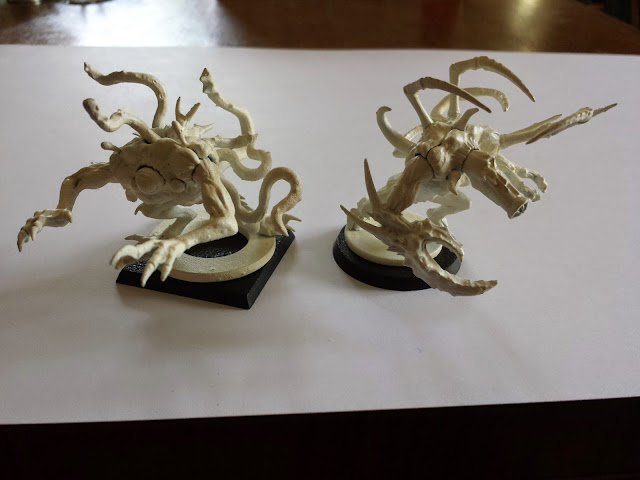Another preparatory step for the painting competition: layering.
Introduction
After painting some Daemonettes a while back, I decided to have a go at a Chaos Spawn model assembled to be used as a Fiend of Slaanesh. I gave it a long snout and crab-like arms and tentacles ending in bony spikes.It was primed the same as the other spawn, using the detail-obscuring graffiti spray:
(the model on the right)
I gave it a light violet base color. This was done using the same technique as for the Daemonettes: heavily watered down Hormagaunt Purple (or equivalent), to a wash-like consistency, laid down on a model primed in white. I also gave the crab claws a coat of bright Xereus Purple (equivalent). On the Daemonettes, this looks fine, since their claws are clearly separated from their arms. The Spawn however lacks that level of detail (as I've previously complained), and it looks somewhat clumsy:
I didn't know of any technique to fix this back then, so I've just left it at that.
Enter layering, the practice of achieving color transitions by successive layers, going from one color to the other. (Really, I could have thought of this.) Check out this youtube tutorial.
Getting at it
My initial plan was to go from the bright purple on the arms to the very light violet on the skin. I re-applied my Xereus Purple (from now on, "purple") on the arms so as to have a strong basecoat to layer on:I waited for it to dry (actually, by the time I painted all the appendages, the first one was dry already), then proceeded to the second layer. I used the same color, with some white mixed in. This is visible in this highly exaggerated contrast induced by the flash:
I left the original color in place around the joints and the inside of the claws, and layered on it everywhere else.
Then for the second layer, I applied more white to the previous mix, and a bit of Daemonette Hide (from now on, "violet").
The fourth and final layer contained more white and violet than the original purple color. I applied it to the edges of the claws, and at the color transition point, so as to smoothly blend into the main skin areas. This is where I realized that I can't reproduce that color anymore, so I went ahead and laid this mix on almost the entire model.
Once dried, this resulted in a weirdly pinkish color:
Which I proceeded to darken down using a black wash. This also popped out the details of the body (muscle groups and fur) and smoothed the transitions near the arm joints.
I then corrected the bony scythes with some light grey on their upper areas, and gave the model tiny, mean red eyes.
I still had some gloss pooling around from the previous spawn model that I've worked on, so I applied some of it on the inside of the claws and scythes, to give them a wicked shine.
I'll leave the base for another time, so that's it!






















































